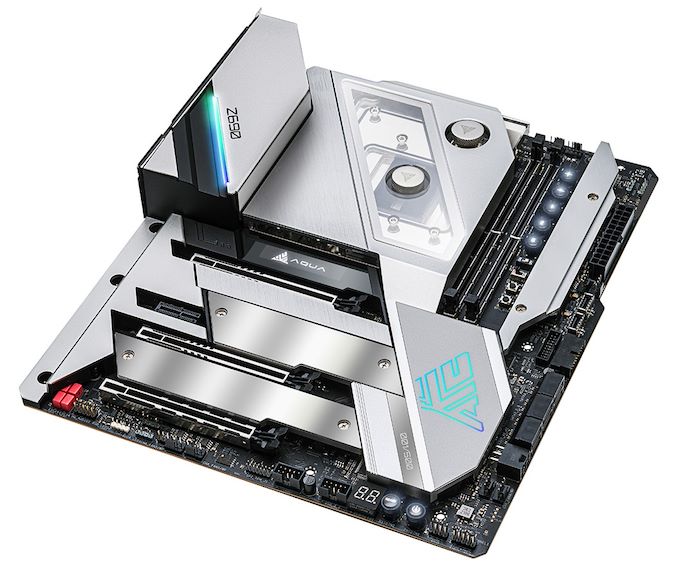The Intel Z690 Motherboard Overview (DDR5): Over 50+ New Models
by Gavin Bonshor on November 9, 2021 9:00 AM ESTASRock Z690 Aqua and Aqua OC (DDR5)
In 2019, ASRock debuted its highly premium yet expensive Aqua series through the ASRock X570 Aqua, which we reviewed. We also reviewed the ASRock Z490 Aqua, and our overall thoughts were that the Aqua was extremely 'cool' in both performance and aesthetics. ASRock at CES 2022 pulled the trigger and launched not one, but two new Aqua series motherboards for Intel's Alder Lake. One features a conventional desktop design, while one is designed for extreme overclockers looking to maximize both compute and memory performance under sub-zero cooling.

The ASRock Z690 Aqua E-ATX motherboard
The ASRock Z690 Aqua has a 'wave' of features, including a large custom monoblock designed to cool both the processor and large advertised 19+1 phase power delivery using the latest premium 105 A power stages. It also includes stainless steel plating across the 12-layer E-ATX sized PCB, with plenty of integrated RGB lighting for users to host their own epic water-cooled discotheque. The ASRock Z690 Aqua also includes an OLED display, which can display many different forms of information from voltages, frequency and can be configured within the BIOS.
Dominating the lower portion of the board are two full-length PCIe 5.0 slots that can operate at x16 or x8/x8, one full-length PCIe 4.0 x4, and one PCIe 3.0 x1 slot, with three PCIe 4.0 x4 M.2 slots that all include M.2 heatsink coverage. For SATA, there are eight ports in total, with four coming from the chipset with support for RAID 0, 1, 5, and 10 arrays, while an ASMedia ASM1061 SATA controller powers the other four. As does most premium Z690 motherboards, the Z690 Aqua can support up to DDR5-6400 memory, with a combined capacity of 128 GB across four slots.

The ASRock Z690 Aqua OC E-ATX motherboard with two DDR5 memory slots and overclockers toolkit
The ASRock Z690 Aqua OC shares the same core feature set but has two memory slots with support for DDR5 memory. As many 'OC' branded boards do, this is to enhance memory performance when overclocking. ASRock also states that it includes an external clock generator to boost OC potential, as well as the exact premium 19+1 phase power delivery as the 'regular' Z690 Aqua. It also includes an overclocker's toolkit next to the memory slots for on-the-fly overclocking. However, both models have a power and reset button, with a two-digit LED debugger.

The ASRock Z690 Aqua rear panel (the Z690 Aqua OC drops two USB 3.2 G2 Type-A ports for a PS/2 port)
On the rear panel, the ASRock Z690 Aqua includes two Thunderbolt 4 Type-C with two DisplayPort 1.4 video inputs, two USB 3.2 G2 Type-A, and four USB 3.2 G1 Type-A ports. The ASRock Z690 Aqua OC has the same layout, except it drops two USB 3.2 G1 Type-A ports for a PS/2 keyboard and mouse combo port. Both models feature a Marvel Aquantial AQC113CS 10 GbE and Killer E3100 2.5 GbE controller pairing, as well as a Killer AX1675 Wi-Fi 6E CNVi. For users planning to use integrated graphics, there's a single HDMI 2.1 video output, as well as five 3.5 mm audio jacks and S/PDIF optical output powered by a Realtek ALC1220 HD audio codec and ESS Sabre 9128 DAC. Finishing off the rear panel is a clear CMOS and BIOS Flashback button pairing.










126 Comments
View All Comments
mode_13h - Friday, November 12, 2021 - link
I was really disappointed not to see more discussion of costs and why the price distribution of these boards tends to skew so high.However, I was most surprised to see how much lower some of the entry-level models are priced. Do we think these will be produced in sufficient volume, or are they primarily there as a means of upselling would-be buyers who, out of frustration at seeing them always out-of-stock eventually end up buying one of the more expensive models?
mikk - Saturday, November 13, 2021 - link
MSI Pro Z690-A WIFI, MSI Pro Z690-A and many more have the cheaper Realtek ALC897 Codec, the audio table is not accurate and it says Z490 instead of Z690.ajollylife - Sunday, November 14, 2021 - link
Wtf is with the PCIe 3.0 slots? I'm looking at the Gigabyte Aorus Master, has 10gig onboard, great, but then the other two pcie slots are pcie 3.0 So confused.mode_13h - Sunday, November 14, 2021 - link
From what I've read, PCIe 4.0 tends to require retimers, which adds cost and takes space. Those could be reasons why we don't see more PCIe 4.0 slots.back2future - Monday, November 15, 2021 - link
maybe mainboards start getting reshaped/redesigned (vertical m.2, backside slots/connectors, ?) instead of using retimers (chipset TDP includes retimer power?, cooling power for peripherals on PCIe 5.x speeds on 4GB/(s*lane)=~2 lanes sufficient for fastest available (2021, consumer) SSDs )?ecclesiastes121314 - Wednesday, February 23, 2022 - link
2 ram slots? I've seen this on a few of these new DDR5 boards. Most people here are talking about Thunderbolt 4 and USB4. Yes these are very useful to a select group of people yet these can be achieved with add on cards. Then you can pay for the devices to take advantage of these technologies. Reducing ram slots from 4 to 2. Wow. Yes you can buy high density ram. But this is forcing you that direction. What is wrong with 4x16 or 4x32 ram kits? If you (me) are interested in high performance video then affordable and available ram is a huge consideration. Is it just me?